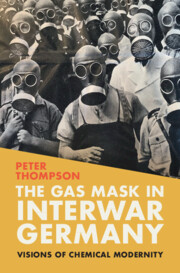Book contents
- The Gas Mask in Interwar Germany
- Science in History
- The Gas Mask in Interwar Germany
- Copyright page
- Dedication
- Contents
- Figures
- Tables
- Acknowledgments
- Abbreviations
- Introduction
- 1 The Structures of Violence: Fritz Haber and the Institutionalization of Gas Warfare
- 2 The Man in the Rubber Mask: World War I and the Development of the Modern Gas Mask
- 3 The First “Chemical Subjects”: Soldier Encounters with the Gas Mask in World War I
- 4 The Limits of Sympathy: The Medical Treatment of Poison Gas during and after World War I
- 5 Atmos(fears): The Poison Gas Debates in the Weimar Republic
- 6 Technologies of Fate: Cultural and Intellectual Prophesies of the Future Gas War
- 7 Synthesizing the “Nazi Chemical Subject”: Gas Masks, Personal Armoring, and Vestiary Discipline in the Third Reich
- 8 Prophets of Poison: Industrialized Murder in the Gas Chambers of the Holocaust
- Conclusion
- Bibliography
- Index
6 - Technologies of Fate: Cultural and Intellectual Prophesies of the Future Gas War
Published online by Cambridge University Press: 11 May 2023
- The Gas Mask in Interwar Germany
- Science in History
- The Gas Mask in Interwar Germany
- Copyright page
- Dedication
- Contents
- Figures
- Tables
- Acknowledgments
- Abbreviations
- Introduction
- 1 The Structures of Violence: Fritz Haber and the Institutionalization of Gas Warfare
- 2 The Man in the Rubber Mask: World War I and the Development of the Modern Gas Mask
- 3 The First “Chemical Subjects”: Soldier Encounters with the Gas Mask in World War I
- 4 The Limits of Sympathy: The Medical Treatment of Poison Gas during and after World War I
- 5 Atmos(fears): The Poison Gas Debates in the Weimar Republic
- 6 Technologies of Fate: Cultural and Intellectual Prophesies of the Future Gas War
- 7 Synthesizing the “Nazi Chemical Subject”: Gas Masks, Personal Armoring, and Vestiary Discipline in the Third Reich
- 8 Prophets of Poison: Industrialized Murder in the Gas Chambers of the Holocaust
- Conclusion
- Bibliography
- Index
Summary
The sixth chapter examines German intellectual understandings of chemical warfare technologies. Several of the most influential interwar intellectuals were veterans of World War I, having experienced gas attacks and used gas masks during their wartime service. Revealing the salience of poison gas in the interwar imagination, this chapter explores the numerous literary, artistic, and cinematic works that attempted to grapple with the individual soldier’s relationship to chemical weapons. Indeed, the continued contact with relentlessly changing and often dangerous technology such as poison gas and the gas mask exemplified the mental uncertainty and political instability of early twentieth-century Germany. As part of a larger debate surrounding militarized technology, arguments over the controllability of poison gas and the viability of gas discipline most clearly played out in the writings of Ernst Jünger and joint projects of Walter Benjamin and Dora Sophie Kellner. These three thinkers constructed highly theoretical visions of aerial warfare technologies that neatly represented two of the major political commitments in the continuing debate over Germany’s potential rearmament and the use of poison gas.
- Type
- Chapter
- Information
- The Gas Mask in Interwar GermanyVisions of Chemical Modernity, pp. 179 - 213Publisher: Cambridge University PressPrint publication year: 2023

